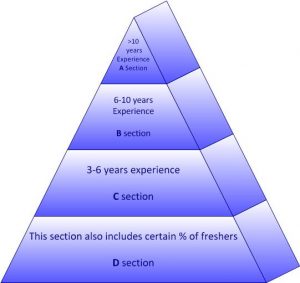Centers of excellence (COEs) are departments within MoxieWise that focus on specific areas, searching both inside and outside the organization to capture new knowledge and practices. Increasingly, we focus more on these COEs, and new technologies that emerge in the market tend to be prototyped here, including the creation of tools that can help bring value to the customer.
A COE comprises a functional or cross-functional team set up as a physical or virtual team, but it has permanent rather than just project status. We define an approach by which tools created by the COE that closely relate to our SRO (IT Service Receiver Organization) technology landscape are validated and adopted at regular intervals. MoxieWise invest in the most valuable projects and create economies of scale for their service offerings via our COEs.
Pyramid Management
MoxieWise ensures that an appropriate pyramid management is in place that ultimately delivers quality service at a reasonable cost. Pyramid management entails ensuring that the correct number of appropriate employees with the desired skills and necessary experience are performing the proper jobs at any given point in time. Our studies have demonstrated that poor or weak pyramid structures can lead to project disasters due to subpar quality and missed deadlines impacting the SRO. In contrast, other studies have demonstrated a reduction in SPO (IT Service Provider Organization) profitability when a heavy pyramid is in place.
A typical pyramid is depicted in the below Figure in this case, profitability is determined by an SPO, and expected quality can be determined by the SRO for a given project. Regardless of the type of contract, the pyramid is a key area requiring validation by the SRO.

Section D consists of resources with fewer than 3 years of experience and typically also includes a percentage of recent college graduates. This is also called the bottom of the pyramid. These are typically junior developers and testers.
Section C consists of resources with mid-level experience (3 to 6 years), also known as mediors. These are typically developers and testers along with some junior designers, senior developers, and senior testers. This is also referred as the bottom +1 of the pyramid.
Section B consists of highly experienced technical resources, including architects, senior designers, and sometimes senior developers. This section is typically referred to as the top – 1 of the pyramid.
Typically, section A consists of project managers and, in some cases, enterprise and business architects, referred to as the top of the pyramid.
A pyramid for a project or a program consists of resources with different experience levels. Some SPOs maintain a lean pyramid and others establish a heavy pyramid, depending on the nature and complexity of the work.
A lean pyramid is one in which a large number of resources are deployed in the bottom and bottom + 1 portions, which results in a majority of less-experienced resources and a minimum of more-experienced resources.
A heavy pyramid is one in which the top and top – 1 portions are assigned more resources than the bottom, which results in few less-experienced resources and many more-experienced resources. However, with a heavy pyramid, you cannot assume that the team will deliver quality results. There should be a proper balance in the different sections of the pyramid to produce a quality deliverable, and this differs from project to project.
